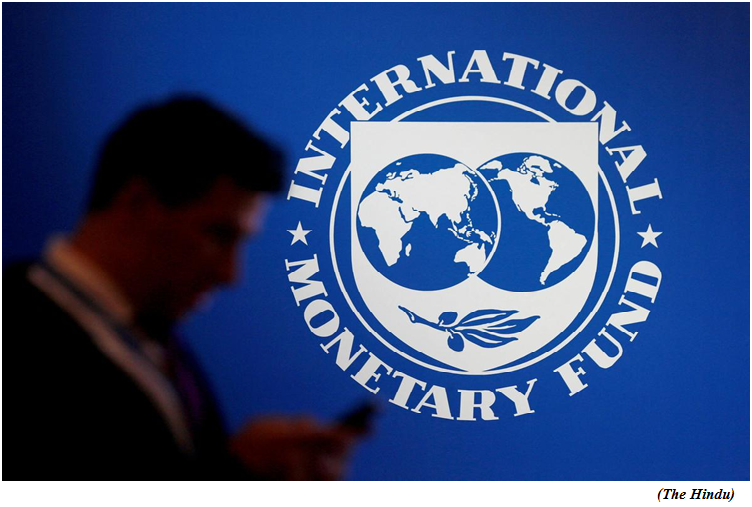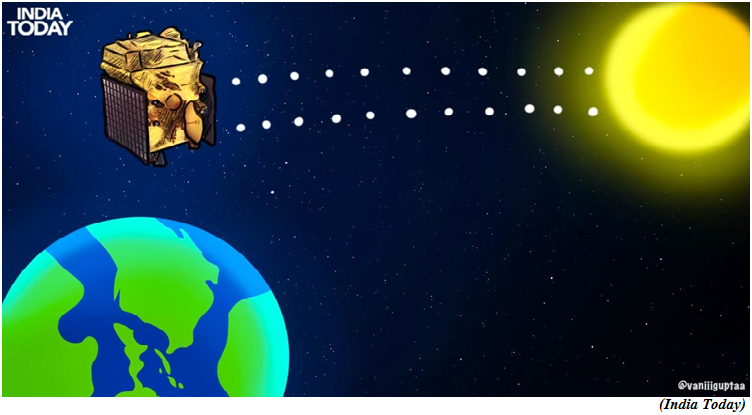IMF lifts 2023 global growth forecast says recession risk lower (GS Paper 3, Economy)

Why in news?
- Recently, theInternational Monetary Fund (IMF) released itslatest World Economic Outlook forecasts.
- It now expects the world economy to grow 2.9% in 2023. That forecast is better than the 2.7% expansion for 2023 that the IMF predicted in October, though down from the estimated 3.4% growth in 2022.
Key Highlights:
- For 2024, the IMF said global growth would accelerate slightly to 3.1%, but this is a tenth of a percentage point below the October forecast as the full impact of steeper central bank interest rate hikes slows demand.
- The recession risks had subsided and central banks are making progress in controlling inflation, but more work was needed to curb prices and new disruptions could come from further escalation of the war in Ukraine and China’s battle against COVID-19.
- The IMF foresees inflation easing in 2023, a result of aggressive interest rate hikes by the Federal Reserve and other major central banks.
- Those rate hikes are expected to slow the consumer demand that has driven prices higher. Globally, the IMF expects consumer inflation to decelerate from 8.8% last year to 6.6% in 2023 and 4.3% in 2024.
Country-wise outlook:
China& India:
- Chinese and Indian economies will supply over 50% of global growth in 2023.
- The IMF now expects China's economy to grow 5.2% in 2023, up from its October forecast of 4.4%.
- China’s economy eked out growth of just 3% in 2022, the first year in more than 40 that China has expanded more slowly than the world as a whole. But the end of virus restrictions is expected to revive economic activity in 2023.
- At the same time, India’s outlook remains robust, with unchanged forecasts for a dip in 2023 growth to 6.1% but a rebound to 6.8% in 2024, matching its 2022 performance.
Europe:
- The IMF's 2023 growth outlook improved for the United States (forecast to grow 1.4%) as well as for the 19 countries that share the euro currency (0.7%).
- Europe, though suffering from energy shortages and higher prices resulting from Russia's invasion of Ukraine, proved “more resilient than expected. The European economy benefited from a warmer-than-expected winter, which held down demand for natural gas.
Russia:
- Russia's economy, hit by sanctions after its invasion of Ukraine, has proved sturdier than expected, too. The IMF's forecast foresees Russia registering 0.3% growth in 2023.
- That would mark an improvement from a contraction of 2.2% in 2022. And it's well above the 2.3% contraction for 2023 that the IMF had forecast for Russia in October.
UK:
- The United Kingdom is a striking exception to the IMF's brighter outlook for 2023. It has forecast that the British economy will shrink 0.6% in 2023; in October, the IMF had expected growth of 0.3%. Higher interest rates and tighter government budgets are squeezing the British economy.
Cautions:
- The global outlook has been shrouded in uncertainty since the coronavirus pandemic struck in early 2020.
- The IMF noted that the world economy still faces serious risks.
- They include the possibility that Russia's war against Ukraine war will escalate, that China will suffer a sharp increase in COVID-19 cases and that high interest rates will cause a financial crisis in debt-laden countries.
Indias Aditya L 1 will unravel the Sun like never before
(GS Paper 3, Science and Technology)
Why in news?
- Why does the Sun behave the way it does? Why are some of the layers of the sun colder than others? What triggers the sun to explode with these deadly ejections? And what all Earth needs to do to be prepared for eventualities from its brightest star?
- The Indian Space Research Organisation (ISRO) is in the final stretch to launch a mission to find answers to these questions. The mission is called Aditya L-1 and it carries a one-of-a-kind instrument that will reveal the Sun's secrets.

VLEC:
- ISRO received the Visible Line Emission Coronagraph (VLEC) on Republic Day to be integrated into the Aditya L-1 mission, bringing it one step closer to the mission launch.
- The coronagraph is one of the most advanced instruments and the biggest on the Aditya L-1 mission. It will be used for imaging and spectroscopy of the Sun to better understand the science powering the star.
- The Sun has two layers, the inner layers - Core, Radiative Zone, and Convection Zone. The outer layers are the Photosphere, the Chromosphere, the Transition Region, and the Corona. While instruments have diagnosed the inner layers, it is the outer layer that remains a challenge to understand.
Focus area:
- VLEC will focus on this outer layer, specifically on the Corona, which starts 2,100 km above the solar surface with a temperature raging around 5,00,000 degrees Celsius.
- VLEC will unravel the Sun's coronal magnetometry as the energy needed for the dangerous Coronal Mass Ejections (CME) from the Sun emerges from the magnetic field in the corona.
- A Coronal Mass Ejection (CME) ejects billions of tons of material into space that often hit Earth triggering auroras and on some occasions even damaging satellites.
- The more explosive CMEs generally begin when highly twisted magnetic field structures in the Sun’s lower corona, making this region highly interesting for solar physicists across the world.
Why is corona so unique?
- VELC aims to collect data for solving how the temperature of the corona can reach about a million degrees while the Sun’s surface itself stays just over 6,000 degrees Centigrade.
- What makes studying the corona extremely difficult is the Sun's bright disk. The corona has so far only been studied during an eclipse when the disk is covered. Scientists have designed VLEC in a way that it occults the solar disc to separate and discard the light from the disk. The light from the corona is captured by the coronagraph for further processing.
What is Aditya L-1 Mission?
- The Aditya L-1 mission is India’s maiden mission to observe the Sun and is expected to launch by mid-2023. Apart from VLEC, the spacecraft will be equipped with six other instruments as well that will explore the science of the Sun.
- While four payloads directly view the Sun from the unique vantage point of L1, the remaining three payloads carry out in-situ studies of particles and fields at the Lagrange point L1.
- The L1 point of the Earth-Sun system provides an uninterrupted view of the Sun and is currently home to the Solar and Heliospheric Observatory Satellite SOHO from NASA. This position provides a greater advantage of observing solar activities continuously.
What is Hindenburg Research, and how does a short seller operate?
(GS Paper 3, Economy)
Why in news?
- The U.S.-based short seller Hindenburg Research has hit back at Gujarat-based Adani Group and accused the conglomerate of “holding back India’s future”.

Details:
- Stocks of Adani Group tumbled after Hindenburg Research published a report titled, ‘Adani Group: How The World’s 3rd Richest Man Is Pulling The Largest Con In Corporate History’, following a two-year investigation, and raised concerns about its “substantial debt”.
- The financial researcher and short seller also accused the conglomerate of stock manipulation and fraud over decades.
- Following the report, Adani Group said it was mulling legal action against Hindenburg Research – a move that was welcomed by the financial researcher.
What is Hindenburg Research?
- Hindenburg Research was founded in 2017 by Nate Anderson, a chartered financial analyst and a chartered alternative investment analyst.
- It describes itself as a forensic financial research company and “activist short seller”. It focuses on analysing accounting irregularities, undisclosed transactions, illegal/unethical business or financial reporting practices among other issues.
- In the past, Hindenburg Research has published reports about irregularities in companies like entertainment company Genius Brands, and electric vehicle manufacturers Nikola Corp. and Mullen Automotive.
- It also made a bet on a decline in Twitter’s share price in 2022 when Elon Musk first offered to buy the company.
What does Hindenburg Research say about the Adani Group?
- Findings of the investigation conducted by Hindenburg Research allege that Gautam Adani, founder and chairman of the group, has added over $100 billion to his net worth over the last three years, largely through stock price appreciation in the group’s seven key listed companies, which have spiked about 819% in the same period.
- The key listed companies under the Adani Group have also taken on substantial debt, including “pledging shares of their inflated stock for loans”. Most top ranks in the company are held by members of the Adani family.
- The investigation also notes that the auditor for Adani Enterprises and Adani Total Gas is a small firm called Shah Dhandharia. Researchers found no current website linked to the firm, while historical archives listed that it had four partners and 11 employees.
What is a short seller?
- A short seller speculates on the decline in the prices of a company’s stocks. An investor who intends to short sell borrows stocks and sells them on the open market, intending to buy them back later for lesser money once the price declines.
- A short seller essentially does not own the stocks they are selling, and bets on a decline in their price in the future, hence taking on a huge risk.
- Investors intending to short sell a stock usually have to borrow it from a dealer or a brokerage company. This is also why the trader must buy the stocks back from the market, even if they are not making a profit, because the stocks need to be returned to the broker.
- The short seller’s profit lies in the money that is left after buying back the stock at a reduced value. However, if the bet doesn’t pay off and stock prices rise, the short seller will incur a loss.
Who are activist short sellers?
- Hindenburg Research has positioned itself as an activist short seller – a financial researcher that investigates companies at length, points out the irregularities and uses its public outreach to criticise a company they have presumed to be overvalued.
- Activist short sellers hope to make profits when stocks of a company they investigated lose value.




